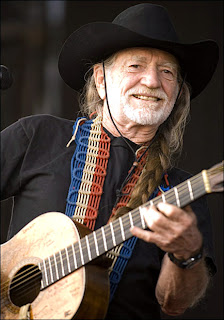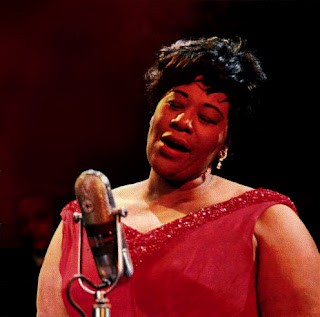Be sure to watch video of Willie Nelson singing "Crazy" at the end of this post.
-----
Did you know?In March 2007, Ben & Jerry's released a new flavor, Willie Nelson’s Country Peach Cobbler Ice Cream, with a portion of Nelson's proceeds donated to Farm Aid.
 |
| "Willie's guitar, Trigger" |
-----
Born in Abbott, Texas, Willie Hugh Nelson started studying music from mail order material that his grandparents gave him. He wrote his first song at age seven and joined his first band at nine. Nelson picked cotton at an early age, and to earn extra money, sang in local dance halls, taverns, and honky tonks beginning at age thirteen and in high school. Nelson was influenced musically during his childhood by Hank Williams, Lefty Frizzell, Ernest Tubb, Django Reinhardt, Ray Price and Hank Snow.
When Willie was in high school his sister married Bud Fletcher, a local musician who invited Nelson to join his band, The Bohemian Fiddlers as their lead singer and guitar player. After graduating from high school in 1950, he joined the Air Force. However, he was discharged due to back problems.
After his return, Nelson attended Baylor University for two years but dropped out because he was succeeding in music. During this time, he worked as a disc jockey in Texas radio stations and a singer in honky tonks.
Nelson moved to Vancouver, Washington, where he wrote "Family Bible" and recorded the song "Lumberjack" in 1956. In 1960, he signed a publishing contract with Pamper Music which allowed him to join Ray Price's band as a bassist. During that time, he wrote songs that would become country standards, including "Funny How Time Slips Away," "Hello Walls," "Pretty Paper," and "Crazy." In 1962, he recorded his first album, And Then I Wrote. Due to this success, Nelson signed in 1965 with RCA Victor and joined the Grand Ole Opry.
 |
| Willie in 1966 |
During the mid 1980s, while creating hit albums like Honeysuckle Rose and recording hit songs like "On the Road Again," "To All the Girls I've Loved Before," and "Pancho & Lefty," he joined the country supergroup The Highwaymen, along with fellow singers, Johnny Cash, Waylon Jennings, and Kris Kristofferson.
During the 1990s and 2000s, Nelson continued touring extensively, and released albums every year. Reviews ranged from positive to mixed. Nelson explored genres such as reggae, blues, jazz, and folk.
Nelson made his first movie appearance in the 1979 film, The Electric Horseman, followed by other appearances in movies and on television.
Today, Nelson is co-chair of the advisory board of the National Organization for the Reform of Marijuana Laws, which is in favor of marijuana legalization.
On the environmental front, Nelson owns the bio-diesel brand Willie Nelson Biodiesel, which is made from vegetable oil.
He is the co-founder and president of Farm Aid, and has been contributing to the benefit concert series since the first event in 1985, organizing concerts and performing with other prominent artists. Nelson is also the Honorary Chairman of the Advisory Board of the Texas Music Project, the official music charity of the state of Texas.
An important collection of Willie Nelson materials (1975–1994) became part of the Wittliff collections of Southwestern Writers, Texas State University, San Marcos, Texas. The collection contains lyrics, screenplays, letters, concert programs, tour itineraries, posters, articles, clippings, personal effects, promotional items, souvenirs, and documents. The collection documents how Farm Aid contributions were used and Nelson's IRS troubles. Most of the material was collected by Nelson friend Bill Wittliff who wrote or co-wrote Honeysuckle Rose, Barbarosa and Red Headed Stranger.
(Continued below video and Amazon portals ...)
(Press album cover for direct link to the entire Amazon Website):
-----
On June 23, 2010 Nelson was inducted to the Library of Congress’s National Recording Registry. Nelson is an honorary trustee of the Dayton International Peace Museum. In 2010, Austin, Texas renamed Second Street to Willie Nelson Boulevard. The city also planned to honor him with a life-size statue to be placed at the entrance of Austin City Limits' new studio.
####
























